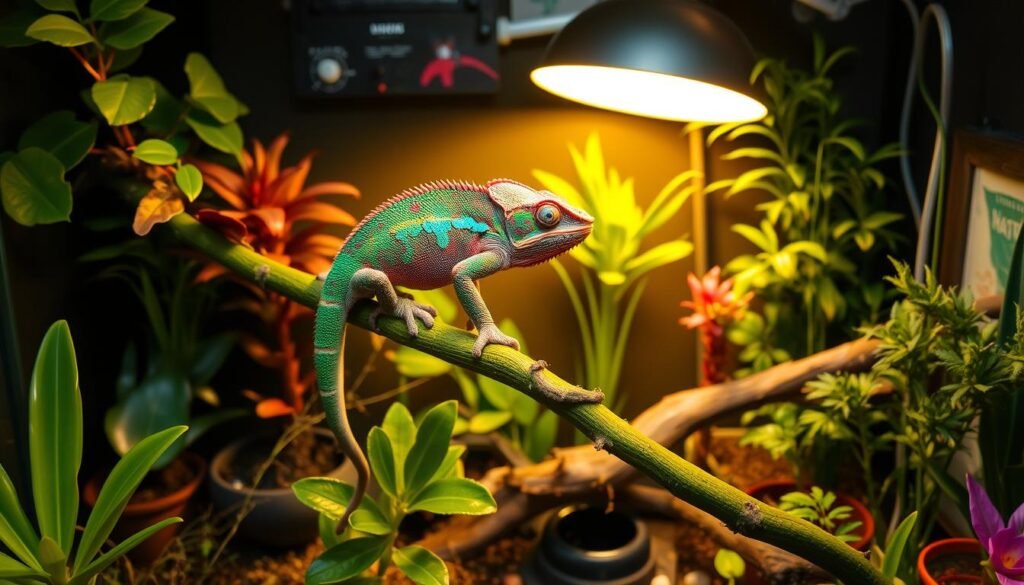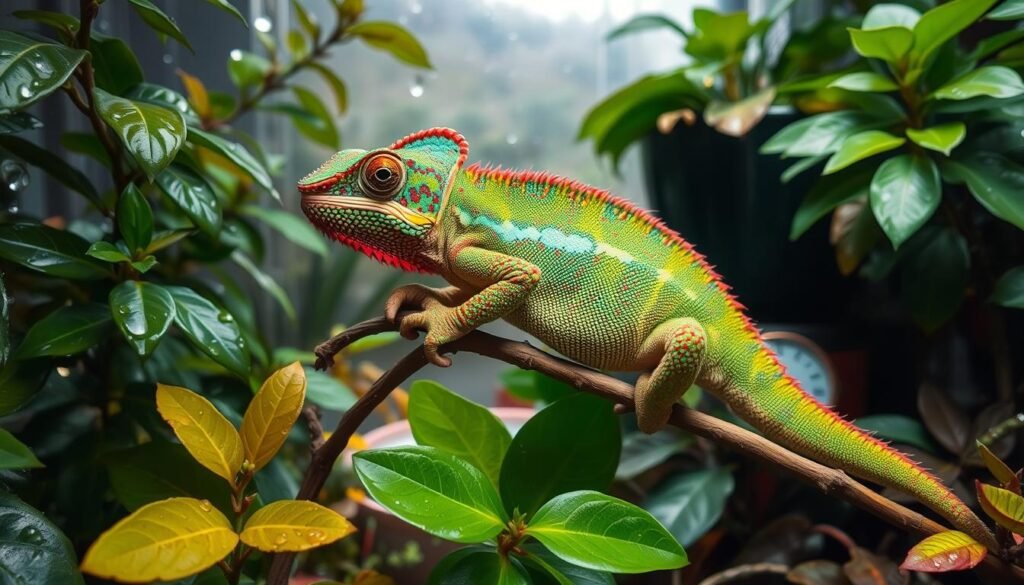
Have you ever seen a chameleon change colour? They are amazing pets but need special care. This care is more than what most people think.
I love reptiles and know chameleons need the right home and care. They make great pets for those who learn about their needs. But, if you don’t care for them right, they can get sick. So, it’s very important to give them the care they need.
Key Takeaways
- Chameleons are exotic pets that require specialist care to thrive.
- Proper equipment and habitat setup are key for their health.
- Knowing their natural ways helps avoid mistakes.
- Chameleons are like watching fish, not very interactive.
- Good care makes owning a chameleon very rewarding.
Understanding Why Chameleons Are Fantastic Pets but Need Specialist Care
Chameleons make great pets, but they need special care. They have their own way of living and eating. Knowing how to care for them is key to their happiness.
Many people think chameleons are easy pets. But they are not. They need a special home with the right temperature and humidity. They also need live insects to eat.
Here are some important things to remember when caring for a chameleon:
- They need a big, well-ventilated home with the right temperature.
- They should eat live insects like crickets and mealworms.
- Keeping the air moist is important, so use a hygrometer.
- Handling them often helps them feel less stressed.
By giving chameleons the right care, you can make them very happy. Remember, caring for a chameleon is a big job. It’s a commitment that lasts for 5 to 10 years, depending on the type.
Essential Equipment for Your Chameleon Habitat
As a chameleon owner, it’s key to give your pet the best home. A good chameleon habitat needs special essential equipment. This includes lighting, temperature control, and humidity management systems.
To make a great habitat, you’ll need:
- A well-ventilated enclosure that’s at least 24” x 24” x 48”
- A heat lamp and UVB lighting for temperature and calcium
- A hygrometer to check humidity levels between 50% to 70%
- A misting system for humidity management and fresh water
Make sure to pick the right gear for your chameleon habitat. Always follow the maker’s guide for setting up and using it. With the right setup and essential equipment, your chameleon will be happy and healthy.
Creating the Perfect Environment
As a chameleon owner, it’s key to make a good home for your pet. You need the right temperature, humidity, lighting, and air. A great home helps your chameleon stay healthy and happy.
Chameleons like it between 65-85°F (18-29°C) and 50-60% humidity. Good air is also important to avoid breathing issues. Use a top-notch air system to keep your chameleon’s air clean.
Light is also important for chameleons. They need UVB light to make vitamin D3. A good light setup has UVB and visible light. Here’s what you need for the best home:
- Temperature range: 65-85°F (18-29°C)
- Humidity level: 50-60%
- Lighting systems: UVB and visible light sources
- Ventilation needs: proper ventilation to prevent respiratory problems
By following these tips, you can make a perfect home for your chameleon. Make sure to learn about your chameleon’s special needs. Some might need different temperatures, humidity, or lights.
| Chameleon Species | Temperature Range | Humidity Level |
|---|---|---|
| Veiled Chameleon | 72-80°F | 50% |
| Jackson’s Chameleon | 70-80°F | 50-80% |
| Panther Chameleon | 75-90°F | 60-85% |
Dietary Requirements and Feeding Schedule
As a chameleon owner, knowing what your pet eats is key. Chameleons love to eat live insects like crickets and mealworms. It’s important to feed them regularly to keep them healthy.
Chameleons need a diet full of live insects for their health. You should feed them a mix of insects and supplements. This mix helps your chameleon stay strong and happy.
When it comes to chameleon food, a balanced diet is vital. You can give them crickets, locusts, and roaches. Make sure to feed them insects that have eaten calcium-rich veggies first. The feeding schedule should match your chameleon’s age, size, and type.
Some important things to think about for your chameleon’s feeding schedule are:
- Give them a variety of live insects and supplements.
- Feed them insects that have eaten calcium-rich veggies first.
- Make sure the food you give them meets their needs.
- Feed them regularly to keep them healthy.
By following these tips, you can help your chameleon stay healthy and happy. Always learn about the nutrition needs of your chameleon’s type. If you’re worried about their diet or health, talk to a vet.
Health Monitoring and Common Issues
As a chameleon owner, it’s key to watch your pet’s health closely. Look for changes in their behavior, eating, and how they look. About 60% of chameleons get metabolic bone disease because they don’t get enough UVB light.
Chameleons can get sick with metabolic bone disease, respiratory infections, and parasites. If your chameleon seems sick or stressed, get them to the vet fast. Not having the right heat in their home can make them sick, but knowing how to care for them can help.
Signs of a Healthy Chameleon
- Strong appetite
- Active behavior
- Clean, shiny appearance
Common Health Problems
These include:
- Metabolic bone disease
- Respiratory infections
- Parasites
When to Seek Veterinary Care
Get your chameleon to the vet if they seem sick or stressed. Early help is important for your chameleon’s health.
| Health Issue | Percentage of Chameleons Affected |
|---|---|
| Metabolic Bone Disease | 60% |
| Respiratory Infections | 20% |
| Parasites | Varies |
Species-Specific Care Considerations
As a chameleon owner, it’s key to know that each chameleon species needs special care. Experts say species-specific care is vital for your pet’s well-being. For instance, veiled chameleons like it humid, while Jackson’s chameleons prefer it drier.
It’s important to research the specific needs of your chameleon species. This includes their diet, habitat, and health checks. By giving species-specific care, your chameleon will be happy and healthy.
Some important things to think about when caring for your chameleon species include:
- Habitat size and temperature needs
- Diet and feeding times
- Humidity and light needs
- Keeping an eye on health and common problems
By knowing what your chameleon species needs and giving species-specific care, you can make a great home for your pet. Always do your research and understand the care considerations for your chameleon species to give them the best care.
Behavioural Understanding and Handling
As a chameleon owner, it’s key to understand your pet well. This means knowing their body language. Signs like hissing or color changes show stress or fear.
It’s also vital to handle them right. This stops injuries and helps with stress management. Supporting their body and tail makes them feel safe. Remember, every chameleon is different.
Here are some tips for handling your chameleon:
- Move slowly and gently to avoid startling them
- Support their body and tail to prevent injury
- Be aware of their body language and behavior to recognize signs of stress or fear
By following these tips, you can make a safe and fun space for your chameleon.
Breeding and Reproduction Basics
As a chameleon owner, knowing about breeding and reproduction is key. Chameleon breeding needs a deep understanding of their biology and behavior. Experts say chameleon breeding has a complex mating ritual. It’s best left to experienced breeders.
For reptile breeding, caring for the breeding pair and their eggs and hatchlings is vital. A female chameleon lays about 30 eggs. But, many breeders don’t raise each baby chameleon. This can cause health issues.
Some important things to think about when breeding include:
- Preparing for breeding: Breeders should get ready for at least 6 months before the first mating.
- Genetic diversity: Choosing unrelated bloodlines is key for genetic diversity.
- Market demand: High-quality genetics are more sought after. Top bloodlines from trusted breeders can boost sales.
Learning about chameleon breeding and reptile breeding helps you make smart choices. Always focus on the health and care of your chameleons. This is important for successful breeding.
| Chameleon Species | Average Number of Eggs | Breeding Preparation Time |
|---|---|---|
| Panther Chameleon | 30 | At least 6 months |
Seasonal Care Adjustments for the British Climate
As a chameleon owner in the British climate, it’s key to change your care routine with the seasons. Seasonal care is vital for your pet’s health. In winter, keep it warm and humid. In summer, make sure it’s cool and well-ventilated.
In winter care, make a warm and cozy space for your chameleon. Use a heat lamp or mat. Keep the temperature between 18-24°C. Also, raise the humidity to 70-90% to stop dehydration.
For summer care, focus on keeping it cool and airy. Make sure the enclosure has good air flow to avoid heat. Keep the temperature between 24-30°C. Also, give a shallow water dish for drinking, as they drink more in summer.
Changing your care with the seasons helps your chameleon stay healthy. Learn what your chameleon needs, as some need special care. With the right chameleon care and seasonal changes, you can make a happy home for your pet.

| Season | Temperature Range | Humidity Levels |
|---|---|---|
| Winter | 18-24°C | 70-90% |
| Summer | 24-30°C | 50-70% |
Social Interaction and Enrichment
As a chameleon owner, you might wonder about social interaction and enrichment. Chameleons are solitary and don’t need to be with others. But, giving them enrichment and stimulation is important. It helps reduce stress and boredom.
Reptile socialization is not needed for chameleons. But, enrichment is key to keep them active and engaged. You can enrich their lives with different foods, like live insects. Also, create a fun environment with plants and decorations.
Here are some ways to enrich your chameleon’s life:
- Change toys and accessories often
- Give them different foods, like live insects
- Make their space fun with plants and decorations
- Let them climb and explore
By enriching their lives, you make your chameleon happy and healthy. Remember, they don’t need to be social. But, enrichment is vital for their well-being.
Long-term Commitment and Costs
Being a chameleon owner means thinking about the long-term. The first costs, like the enclosure and food, can be high. They can cost between $300 to $400. Also, remember the ongoing costs for food and vet visits.
Looking after a chameleon takes a lot of time every day. The costs can change based on the chameleon’s needs. But, it’s important to plan for both the start-up and ongoing costs. This ensures your chameleon gets the best care.
Initial Setup Expenses
- Enclosure: $100-$200
- Equipment: $50-$100
- Initial food and supplements: $20-$50
Ongoing Maintenance Costs
- Food and supplements: $20-$50 per month
- Veterinary care: $50-$100 per visit
Knowing the long-term costs helps you decide if a chameleon is right for you. It also helps you give your chameleon the best care.
| Expense | Cost |
|---|---|
| Initial setup | $300-$400 |
| Ongoing maintenance | $20-$100 per month |
Conclusion: Embracing the Chameleon Care Journey
Chameleons are amazing pets that bring joy and learning. They need special care, like the right temperature and lighting. This makes caring for them a big responsibility.
Getting the right gear, like Dragon Strand Hydration Mounts, helps a lot. It keeps the air right for them. Adding misting systems and plants makes their home better.
Keeping your chameleon healthy is key. Watch their health, feed them well, and listen to what they say. It might be hard, but it’s worth it to see them happy.
Chameleon care is a big adventure. It teaches you a lot about reptiles and exotic pets. With hard work and love, you’ll enjoy every moment.